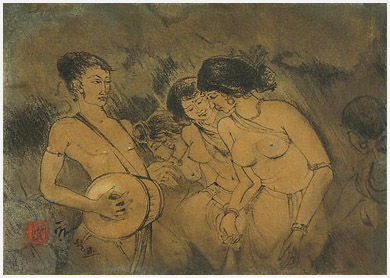EDUCATION
1903-05 Commercial Class, Presidency College, Calcutta.
1905-10 Student of Abanindranath Tagore, Govt. School
of Art and Craft, Calcutta.
EXHIBITIONS
1908 Inaugural Exhb., Indian Society of Oriental Art,
Calcutta. 1909 Indian Society of Oriental Art Exhibition,
Simla. 1910 Exhb. at Indian Society of Oriental Art,
Calcutta. 1911 Indian Society of Oriental Art, United
Provinces Exhibition, Allahabad . 1911 Festival of Empire,
Crystal Palace, England (Organised by Indian Society
of Oriental Art, for George Vs Coronation). 1912 Exhb.
at Indian Society of Oriental Art, Calcutta. 1914 22nd
Exhibition of Societe des Peintres Orientalistes Francais,
Grand Palais, Paris. (Travelling to Belgium, Holland
and Imperial Institute, England). 1915 Exhb. at Indian
Society of Oriental Art, Calcutta. Young Men`s Indian
Association, Madras. 1916 Exhb. at Indian Society of
Oriental Art, Calcutta. 1924 Travelling Exhb. in USA
(Organised by American Federation of Art & Indian
Society of Oriental Art). 1928 Athenee Gallery, Geneva,
Switzerland. 1935 Lucknow Session of the Indian National
Congress. 1937 Haripura Posters, decorated
COLLECTION
Indian Museum, Calcutta. National Gallery of Modern
Art, New Delhi. Rabindra Bharati Museum, Calcutta. Nandan
Museum, Kala Bhavan, Santiniketan. Victoria and Albert
Museum, London. University of Sussex, England. Delhi
Art Gallery, New Delhi.
AWARDS
1950 He was awarded D.Litt., Benaras Hindu University,
Benaras. 1952 He was awarded D.Litt., Visva Bharati
University, Santiniketan. 1953 Received the Dadabhai
Naoroji Memorial Prize. 1954 Govt. of India honoured
him with Padma Bhushan. 1956 Lalit Kala Akademi honoured
him with fellowship. 1957 He was awarded D.Litt., Calcutta
University, Calcutta. 1958 Silver Jubilee Medal, Academy
of Fine Arts. 1963 He was awarded D.Litt., Rabindra
Bharati University, Calcutta. 1965 Received Tagore Birth
Centenary Medal from the Asiatic Society of Bengal.
He was awarded the title of `National Art Treasure`
by the Govt. of India.
STYLE
Of the many artists thrown up by the revivalist movement
at the turn of the century Nandalal Bose was the best
and the best known. He was the one with the Midas touch
in terms not of commercial valuation but of artistic
impact. Even today his art is as relevant as ever before.
In his first phase, he excelled in the wash technique
and his compositions and drawings gradually became firm
and design oriented. His second phase, he explored and
re-interpreted the traditional sculptural forms and
folk paintings of Bengal. It was a significant shift
from the epic-puranic watercolour wash to the vibrant
Linear expression of the life of the common people.
Lastly, in his most endearing phase Nandalal fused the
Japanese sensibilities for the unadorned linearity of
forms in untreated pictorial space with tribals, the
trees, the mountains and vast open fields.
TEACHING EXPERIENCE
1910-14 Part-time teaching at Jorasanko, Nivedita
Girl`s School, Calcutta. 1916-17 Part-time art Classes
at Vichitra Club. 1918-21 Indian Society of Oriental
Art, Calcutta and temporary work at Kala Bhavan, Santiniketan.
1922- 51 He was the first Principal at Kala Bhavan,
Santiniketan.

back |



